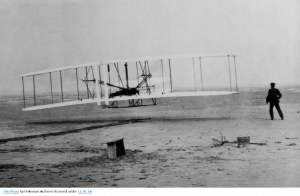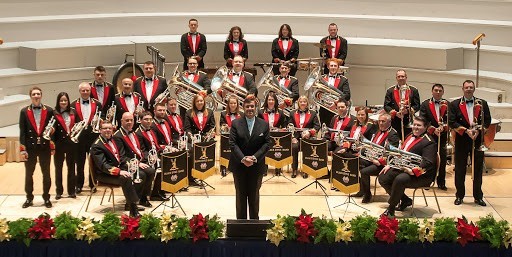
Start with YOU, not with WHY!
How it all began
As this is the 300th edition of the Police Aviation News I thought that it was only appropriate to write an article that looked at the very reason why we all enjoy reading the publication and are all so passionate about the benefits of flight, specifically how it benefits so many people in their hour of need. From an emergency service perspective there is nothing better than to save a fellow human’s life, to assist in the capture a dangerous criminal or to find a vulnerable missing person who otherwise would not have been located. To make a very real and positive difference gives you an amazing buzz, fulfillment and a sense of worth and achievement. But how did it all begin back in 1903?
In July 2018 I was fortunate enough to deliver a presentation to the Continuous Improvement Meeting (previously known as the Police Eurocopter User Group) in Oxford. My presentation brief was to provide the assembled delegates, from both Eurocopter and the National Police Air Service, a base manager’s perspective of running a police air base. In this case Lippitts Hill and previously Halfpenny Green. I was a bit cheeky and decided to push the envelope ‘slightly’ by asking a question of the delegates and that was,
‘How does a public organisation form a synergy with a private commercial company? In essence how does a non-profit community focused organisation (NPAS) work with a private, profit focused company (Airbus)?’
Attempting to answer this particular conundrum I resorted to Simon Sinek (author of ‘Start with Why’) and used an example from his book to illustrate my thinking. What was the ‘why’ of each organisation and could they fundamentally work alongside each other by understanding each other’s respective positions?

To illustrate the problem and to expand the thinking, both inside and outside of the meeting room, potentially seeking some form of agreeable consensus I used a passage from Simon Sinek’s book as it seemed appropriate and fitted perfectly into the theme of the presentation. It was in fact the story behind how the first ever heavier-than-air, machine-powered, controlled human flight was achieved. Once again, I started with a question to the audience and it was this,
‘Who is this person?’


Thankfully, no one knew who it was and it certainly wasn’t my father, as one member of the audience guessed! If they had actually known the gentleman’s name it would also have spoilt the rest of the presentation. The gentleman in the picture was in fact the person who really should have, well on paper, achieved that first historic flight. His name was Samuel Pierpont Langley.
Langley was an acclaimed American academic being an astronomer and professor of mathematics who could boast of prestigious personal connections such as Andrew Carnegie and Alexander Graham Bell. He was also funded to the sum of $50,000 ($3m dollars in today’s money!) by the United States War Department. He even employed a test pilot by the name of Charles Manly and also mechanical engineers. The team had access to the best materials and the media of the day were following Langley and his team everywhere, waiting for the moment when that inevitable inaugural flight was achieved. They had, at least on paper, all of the ingredients for success and seemingly could not fail to claim the fame and glory, along with the inevitable financial rewards, that would follow their seismic success. The printing presses were all primed and set to run with the news of the first flight once Langley and his team had achieved it.
So, when asked who the man in the picture is, why does no one really know of or has ever heard of Samuel Pierpont Langley and more importantly, why was he beaten to the prize by a group of non-academic bicycle makers from North Carolina, the Wright brothers? It doesn’t really make sense!



Orville and Wilbur Wright had no funding, no high-level connections and not one of the team possessed a college education between them. How on earth then could they then achieve the ultimate goal of flight when they had none of the ingredients for success but seemingly all the ingredients for failure?
What they did have was the ability to understand the root cause of the problem that they were ultimately facing, which for them was the issue of balance and flight. Langley was focusing his team’s energies on power.
It is written that every time the Wright brothers and their team went flying, they took with them five sets of parts with them as they knew it would require that amount of mechanical support and experience of failure before they convened for the day.
However, on December 17th 1903 in a field in Kitty Hawk, North Carolina they achieved their goal. Orville flew the fragile aircraft for a grand total of 59 seconds and 852 ft in distance at a dizzy altitude of 120 ft at the speed of ‘a jog’ they created history. A moment of history from which we all benefit and to some extent, we all take for granted.

In Simon Sinek’s book it speaks of the Wright brothers having the right ‘‘why’’. The ‘’why’’ is described as being their passion and inspiration which took the team with them on this quest. They saw the huge benefits that the ability to fly would bring to the world, bringing with it astonishing change. They were not in this race for the fame, recognition or financial reward but they clearly understood and realised what the impact of flight would have on the world, and it certainly did. If they had not achieved this amazing feat then I would not have enjoyed some 18 years flying and the Police Aviation News would not exist! Langley, on the other hand, was attempting to achieve greatness for his own personal gain and for that reason did not have that all important ‘‘why’’. He was therefore perceived as doing it for the wrong reasons.
I would like to take Simon Sinek’s argument a step further and attempt to explain this remarkable achievement not through the ‘’why’’ factor but through linear and non-linear thinking.
Let us first define the difference between linear and non-linear thinking;
Linear Thinking is a process of thought following known cycles or step-by-step progression, where a response to a step must be elicited before another step is taken.
Non-Linear Thinking is human thought characterised by expansion in multiple directions, rather than in one direction, and based on the concept that there are multiple starting points from which one can apply logic to a problem.
You may well see these two different types of thinkers in your teams or organisation…
If we first analyse Mr. Langley, who incidentally quit aviation soon after hearing the news of the Wright brother’s success. It was said that he found the defeat personally humiliating, especially as his effort crash landed in the Potomac River. The once besotted newspapers made fun of his failed efforts and his ego was destroyed as a result. Interestingly, he and his team could have easily learnt from the Wright brothers and conducted further development, improving the idea further. They chose not to.
After assessing what evidence there is available of Mr. Langley a linear thinking process prevailed. The money, the academic support, the materials and the connections were all in place but the one missing element was not the ‘‘why’’ but the ability to think, or to have someone within the team to think in a non-linear manner. They would solve the issue step by step by step. It would have potentially required only one non-linear thinker within that team to have considered all of the scientific evidence gathered and to have possibly suggested that they were not looking at the right problem from the right direction. That ‘different thinking’ around the problem was the missing link, the missing piece of the jigsaw that equated to either success or failure, fame or ignominy.
How many times have you heard a dissenting voice, possibly in a meeting, suggest that there was another possible option, another solution, another route to success only for them to be told, metaphorically, to ‘get back in your box’? They may not have had the experience, the rank, the stature or position or they were deemed by the hierarchy to be of little relevance. The tried and trusted ‘set in stone’ linear dominant thinking and processes that form the all too familiar ‘we’ve always done it this way’ mentality, prevail. That dissenting voice may actually be your non-linear thinker who possesses that rare ability to see around corners and to provide innovative and creative solutions that others simply did not see. They make the complex appear simple and see complex issues as being simple. Unfortunately, when the solution is pointed out to the linear leader, the leader becomes naturally defensive as they feel that it should have been them who had spotted this obvious solution. Is this not how a certain Mr. Langley behaved? Embarrassed they generally tend to belittle the solution and revert to the ‘we have always done it this way’ stance. The non-linear thinker, who proposes the solution, then becomes frustrated and subdued and either leaves the organisation or resigns themselves to remaining in the shadows, happy to just play their part in the inevitable failure, disappointment and inevitable ‘finger pointing’ as to who personally caused the failure.
If we now look at the Wright brothers let’s see why they were the ones to have achieved powered flight. Were they in fact the Elon Musk of their day? If you equate achieving flight in 1903 to landing humans on Mars in 2021 there is a definite correlation!
There is a great quote from James Tobin’s book on the Wright brothers and its states,
‘Wilbur and Orville were true scientists, deeply and genuinely concerned about the physical problem they were trying to solve – the problem of balance and flight’.
We can easily transfer this observation to Elon Musk and his SpaceX project. Assuming that Elon Musk is a Polymath, a person who has specialist interests in many specialisations with an overlapping insight, we can see this in the Wright brothers. That ability to have an overlapping insight was that the missing ingredient in Samuel Pierpont Langley’s team. Langley fits in with being either a linear Specialist, or complex Generalist as they are individuals who can function across many disciplines but not necessary being a specialist in all.
There is a notable transitional zone that occurs between the Specialist and the Generalist. Individuals within this zone (Specialist/ Generalist) are often identified as complex capable due to their extensive ability to reference past experiences as Specialists, despite not being sufficiently complex capable.
Langley also had one larger issue. His Achilles heel if you like. If we assume that Langley was in fact a linear thinker, we know that linear thinkers find it difficult to identify errors in systems as those systems become more complex. Linear thinkers also overcomplicate systems during the design process through linear sequencing. This was evident in the linear sequencing Langley introduced to his project in terms of:
Academic Qualifications – Experience – Credibility – Money – Engineers – Test Pilot – Connections – Materials = Guaranteed Success
This is where the Wright brothers had the huge advantage over Langley and ultimately brought them the prize of flight and it wasn’t, as Simon Sinek argues, their ‘’why’’. As non-linear thinkers they could deal with systems and were able to introduce change and innovation in systems or if necessary, design new systems. They certainly did not have any of the monetary or other perceived advantages and benefits that Langley had access to.
This example then begs another more relevant and ‘here and now’ question which is,
‘how do we consistently build high performing teams that can solve complex problems?’
How do we to replicate the Wright brother’s team formula time and time again? Google recently spent millions of pounds seeking this missing ingredient during their Project Aristotle and still do not have a coherent answer to the conundrum. David Marquet’s bestselling leadership book, ‘Turn the Ship Around’ explains what happened on board his nuclear submarine, Santa Fe, but has this particular crew ethos and intent based leadership style ever been replicated again?
Police aviation, air ambulance, coastguard all seek to bring teams together and develop them under the banner of crew resource management but it actually goes back well before even CRM kicks in. Organisations need to recruit people with the ability to think in both a linear and non-linear manner but they then need to align that innate talent to the correct role throughout all strands of the business, from the cleaner to the CEO. We will then reap the benefits of having people not falling into burn out but instead, fulfilled and happy in their role. We also organically develop that all important psychological safety in order to solve those problems that face us on a daily basis. Another huge benefit will be that people’s home and social life will thrive as the stresses of work do not then permeate into it. If you are happy at work you will be happy at home and vice versa as home and work are intrinsically linked. We also need to highlight who the Polymaths are amongst those teams and organisations and when you find them, build that psychological safety around them so that they and the organisation can flourish.
Only once you truly know yourself and your people will you then witness your organisation fly, as a result of your people, not at the expense of them.
Categories
- Anti Bullying (2)
- Aviation (2)
- Business (2)
- Motivation (1)
- Self Awareness (5)
- The Book! (1)



